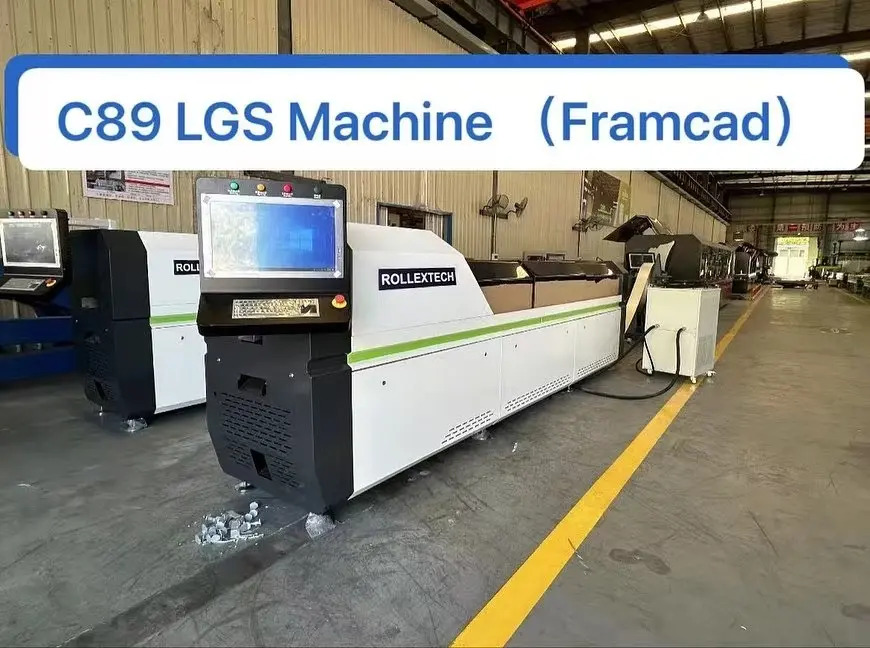
In the field of modern construction, with continuous advancements in technology and rapid developments in material science, various innovative construction methods and materials are emerging. Among them, the LGS machine (Light Gauge Steel Framing Machine) has gradually demonstrated its unique advantages as an efficient and environmentally friendly construction device. This article will provide a brief introduction to the basic concept of the LGS machine and explore its significance in modern construction.
An LGS machine, also known as a Light Gauge Steel Framing Machine, is a device that uses hot-dip galvanized steel strips and applies cold roll forming technology to manufacture light steel frame systems. This machine can precisely process and assemble high-strength, lightweight, and easy-to-install steel structural components, offering a new solution for modern construction. Next, we will elaborate on the importance of LGS machines in the construction industry from various perspectives.
What is an LGS Machine?
An LGS machine is a specialized and efficient device used for manufacturing light gauge steel frames. The term “LGS” stands for Light Gauge Steel Framing Machine.
The core working principle of an LGS machine is based on cold roll forming technology. In this process, hot-dip galvanized steel strips are fed into the machine and pass through precision-engineered cold roll forming molds. These molds are customized according to the predetermined shapes and dimensions of the steel frames. Through a gradual bending and forming process, the originally flat steel strip is transformed into light gauge steel studs with specific cross-sectional profiles.
Cold roll forming not only ensures the high precision and strength of the steel studs but also significantly improves production efficiency. As a result, LGS machines can rapidly produce large quantities of light gauge steel framing components that meet design requirements. These components can be swiftly assembled on construction sites, greatly shortening the construction period and reducing building costs.
Key Features of LGS Machines
The LGS machine plays an increasingly important role in modern construction due to its precision engineering, integrated automated steel frame design, high production efficiency, and versatile manufacturing capabilities. It not only improves construction quality and efficiency but also reduces building costs, injecting new vitality into the development of modern architecture.
1. Precision Engineering
The LGS machine utilizes advanced cold roll forming technology, ensuring high precision and quality in steel frame components. With meticulously designed and manufactured molds, the LGS machine can produce light gauge steel studs that meet strict dimensional and shape requirements, providing strong support for building stability and safety.
2. Automated Steel Frame Design Integration
In addition to its high-precision machining capabilities, the LGS machine is equipped with integrated automated design systems. Users can input building requirements and parameters via software, and the LGS machine will automatically generate the corresponding steel frame design and proceed with precise processing and assembly. This automated integration greatly enhances design efficiency, accuracy, and reduces both project timelines and design costs.
3. Enhanced Efficiency
The LGS machine is known for its high production efficiency. By employing continuous cold roll forming and automated processing, it can rapidly produce large volumes of light gauge steel frame components in a short period. This efficient production method not only improves productivity but also reduces manufacturing costs, making the LGS machine an essential tool in modern construction.
4. Versatile Manufacturing Capabilities
The LGS machine is not limited to producing simple steel frame components. It is capable of manufacturing a variety of building elements, including walls, trusses, and flooring systems, meeting the diverse needs of modern architecture. This versatility expands the application potential of LGS machines across various construction projects.
Applications of LGS Machines
The LGS machine, with its efficiency, precision, and versatility, demonstrates extensive application potential in modern construction. Below are some key areas where the LGS machine is widely used:
1. Residential and Commercial Buildings
In the field of residential and commercial construction, the LGS machine plays a vital role. It can efficiently and accurately produce light gauge steel frame components that are lightweight, strong, and easy to assemble. These characteristics make LGS components ideal for constructing walls, roofs, and floor structures in modern residential and commercial buildings.
By utilizing LGS machine-manufactured frames, architects and developers can achieve flexible design layouts while enhancing stability and safety. Additionally, the LGS machine’s high production efficiency significantly reduces construction timelines and costs, making residential and commercial projects more cost-effective and affordable.
2. Modular and Prefabricated Structures
The LGS machine plays an important role in the growing trend of modular construction and prefabricated structures. It can produce standardized light gauge steel frame components that are pre-assembled into modules or prefabricated units in the factory. These modules are then transported to the site for quick assembly.
This method not only enhances construction efficiency but also minimizes on-site labor, reducing potential risks and challenges during installation. Since LGS frame components are lightweight yet strong, they are particularly well-suited for transportation and installation in modular and prefabricated projects.
3. Industrial and Warehouse Projects
The LGS machine is also widely applied in industrial and warehouse projects. Such projects typically require large-scale, high-strength structures capable of supporting heavy equipment and stored goods.
The LGS machine can produce durable steel frame components tailored for walls, roofs, and support structures in these environments. By utilizing LGS machines, industrial and warehouse projects can be constructed more rapidly while ensuring structural stability and load-bearing capacity. Additionally, the machine’s high production efficiency helps reduce construction costs, making industrial and warehouse developments more economically viable.
Advantages of LGS Machines
The LGS machine offers several advantages, including fast construction speed, high efficiency, strong structural strength and durability, cost-effectiveness, material savings, and eco-friendly construction. These benefits make the LGS machine highly applicable and promising in the construction industry. Below is a detailed explanation of these advantages:
1. Fast Construction Speed and High Efficiency
The LGS machine employs advanced automation technology, enabling the rapid production of precise building components. This high-efficiency production process significantly shortens construction timelines and improves overall efficiency.
Additionally, the LGS machine supports modular production, where building components are pre-assembled into modules before being transported to the site for quick assembly. This further accelerates the construction process, making it an ideal solution for projects requiring speed and precision.
2. Strong Structural Strength and Durability
The light gauge steel frame components produced by the LGS machine are known for being lightweight, high-strength, and corrosion-resistant. These characteristics allow the components to bear substantial loads, enhancing the stability and safety of the building.
Moreover, thanks to the durable properties of light gauge steel materials, LGS machine-manufactured components have a long service life, meeting the requirements for long-term building use.
3. Cost-Effectiveness and Material Savings
The LGS machine’s efficient production capabilities significantly reduce manufacturing costs. Since light gauge steel materials are lightweight yet strong, they require fewer raw materials, further lowering overall construction costs.
In addition, the LGS machine’s precision manufacturing minimizes material waste, improving material utilization rates and ensuring a more economical construction process.
4. Eco-Friendly Construction with Minimal Waste
The LGS machine adopts eco-friendly production processes and materials, reducing environmental pollution.
Thanks to its precision manufacturing and modular production, the LGS machine minimizes construction waste and on-site debris, reducing environmental impact. Furthermore, the LGS machine promotes resource recycling, improving material efficiency and supporting sustainable building practices.
Comparison Between LGS Machines and Traditional Construction Methods
In the construction industry, the LGS machine has emerged as a modern construction tool, offering significant advantages over traditional methods in terms of installation speed, material efficiency, and structural flexibility. Below is a detailed comparison of the two approaches:
1. Installation Speed
LGS Machine:
The LGS machine utilizes automated production technology, enabling the rapid manufacturing of precise building components. These components are pre-assembled into modules in the factory and then transported to the site for quick assembly. This modular production method significantly shortens construction timelines and enhances installation speed. Compared to traditional methods, the LGS machine can complete projects much faster.Traditional Construction Methods:
Traditional construction methods rely heavily on manual labor and wet operations on-site, such as concrete pouring and bricklaying. These processes are time-consuming and influenced by factors like weather conditions and workforce efficiency. Consequently, traditional methods tend to have slower installation speeds.
2. Material Efficiency
LGS Machine:
The LGS machine utilizes lightweight steel materials, known for their high strength, lightweight properties, and corrosion resistance. During manufacturing, the LGS machine achieves precise cutting and assembly, reducing material waste. Additionally, the use of lightweight steel reduces the overall weight of the building, minimizing the need for extensive foundation work and lowering foundation costs. As a result, the LGS machine demonstrates excellent material efficiency.Traditional Construction Methods:
Traditional methods often use materials such as concrete and bricks, which are prone to waste during transport, storage, and construction. Furthermore, traditional construction often requires a large number of formworks, supports, and other auxiliary materials, further increasing material costs. Thus, traditional methods tend to have lower material efficiency.
3. Structural Flexibility
LGS Machine:
The LGS machine produces standardized and modular lightweight steel frame components. These components can be flexibly combined and adjusted to meet various building layouts and functional needs. Moreover, lightweight steel materials offer excellent ductility and malleability, enabling them to adapt to complex architectural designs and structural requirements. As a result, the LGS machine excels in structural flexibility.Traditional Construction Methods:
Traditional construction methods are limited by material properties and construction techniques, resulting in lower structural flexibility. Materials like concrete and bricks are generally fixed in shape and size, making it challenging to accommodate complex architectural designs. Additionally, the reliance on extensive on-site manual labor and wet processes further restricts the adaptability of traditional methods.
Conclusione
With continuous technological advancements and the ongoing development of the construction industry, the LGS machine has emerged as a significant innovation tool in modern architecture, with its importance and role becoming increasingly prominent. Through efficient, precise, and eco-friendly production methods, the LGS machine not only greatly enhances construction speed and quality but also drives transformative changes within the industry.
The application of LGS machines has led to a substantial breakthrough in structural design and construction efficiency. Its high production efficiency ensures the rapid manufacturing of building components and swift on-site assembly, significantly reducing construction timelines and costs. Meanwhile, the lightweight steel frame components produced by LGS machines boast features such as lightweight properties, high strength, and corrosion resistance, improving building stability and safety to meet the high demands for structural strength and durability in modern architecture.
More importantly, the introduction of LGS technology is profoundly reshaping traditional construction methods. It drives the industry’s digital transformation and smart upgrades, making building design, construction, and management more efficient, precise, and sustainable. By integrating advanced automated design systems and modular production methods, LGS technology presents the construction industry with unprecedented innovation and development opportunities.




